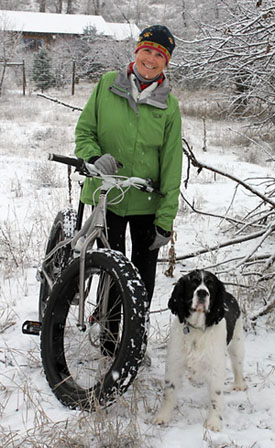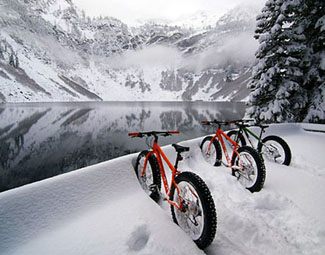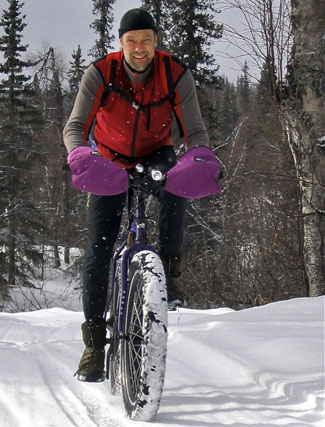|
 Above and Grist front page photo courtesy of Steve Mitchell Above and Grist front page photo courtesy of Steve Mitchell
by Karen West
 Sally Ranzau, one of the first fatbikers in the Methow Valley, with her dog, Remy. Photo by Karen West The Methow Valley is joining other winter sports destinations this season in welcoming the relatively new and growing sport of fatbiking, which means riding a large-framed bicycle with extra wide tires on snow.
A handful of the Methow Valley Sport Trail Association’s groomed ski trails will be open to fatbikes as part of a pilot project. In addition, a volunteer effort is bringing new multi-use trails to Pearrygin Lake State Park and the old Lloyd ranch property owned by the Washington Department of Fish and Wildlife. (See sidebar story on trails and rules.)
Two free fatbike demonstrations are scheduled from 9 a.m. to 1 p.m., Sundays, Dec. 16 and Jan. 13, at the Winthrop town trailhead. Both are hosted by Methow Cycle and Sport, which rents the bikes.
The “Whee Factor”
“I was about the first person in the valley to ride a fatbike,” says Winthrop resident Sally Ranzau, who took up the sport three years ago after a bad shoulder meant missing a season of skiing. “Right now probably only a handful of people in the valley are doing snow biking,” she said, adding that “It’s huge up in Alaska.”
Knowing his mom couldn’t ski with her bum shoulder, Ranzau’s savvy son, who lives in Anchorage, built her a 9:Zero:7 aluminum fatbike frame and shipped her everything but the wheels. Joe Brown, who owns Methow Cycle and Sport, built wheels, and she was underway.
Ranzau’s been riding on the MVSTA’s multi-use Big Valley trail with her dog, Remy, for the last two winters and reports that not one person has been critical, just curious. She explains that fatbikes are ridden on the packed skating platforms, never in the groomed classic tracks. Because the tires are 3.7 inches to more than 4 inches wide, they leave less footprint than skate skis do, according to Ranzau and other experienced riders.
 A group from the Methow Valley Sport Trail Association gave fatbikes a try by riding into Rainy Lake before the North Cascades Highway closed for the season. Photo by Kristen Smith
“If it’s cold and there’s not a ton of new snow, it’s hard to even see evidence of a fatbike,” says Brown, who’s been riding them for the last three years. Nordic and backcountry skiers and mountain bikers are especially showing interest in the sport, he adds.
It’s a “floating” sensation and you ride by feel, adds Ranzau. “When in doubt, let air out” is the fatbike rule of the road, she says. As for speed, most riders go faster than classic skiers but not as fast as skate skiers. “It’s not about the speed,” she added. “It’s about where you can go.”
“My whole thing is that it’s just fun,” Ranzau says. “It’s totally different from a regular bike... I call it the ‘whee factor’... It’s not about your mileage or the destination ... It’s just about the experience and the smiles.”
The Iditabike
It’s also about the experience for Steve Mitchell, who has been cycling on snow since 1988, when he entered the second annual Iditabike – a 200 mile competition on a section of the Iditarod Trail Sled Dog Race course outside Anchorage, Alaska. “I had no clue what I was into,” he admits.
 Steve Mitchell, who first rode fatbikes in Alaska, shows the handlebar covers, called pogies, and the insulated, covered boots he devised to help stay warm. Photo courtesy Steve Mitchell In those days there were no specialized bikes. The contestants rode mountain bikes. The course was in the Knik Lake area – 100 miles out and a long loop back, Mitchell says. The first 15 to 20 miles the riders “moved right along” on a frozen surface used by snowmobiles and dog teams. But, says Mitchell, conditions changed and “for the next 60 miles most of us walked and pushed.” He estimates it took him 15 hours and one bivouac to slog those 60 miles.
Fortunately, conditions were better for the last half of the race, although Mitchell says it took him more than 50 hours to complete the course. But, he adds, “... we came away from that event enamored of biking on snow.”
Mitchell, who now owns Winthrop’s Rocking Horse Bakery with his wife, Teresa, grew up in Wisconsin. He was single and in the mountain bike business in Seattle at the time he entered his first Iditabike. “I’ve always been a cyclist,” he says. In 1989 he entered his second Iditabike after learning more about gear and tire pressure. He says he cut a half-day off his race time. “It’s all about buoyancy,” he explains. “How do you stay on top of the snow and keep from pushing through?”
Mitchell says as time went on several mountain bikers started experimenting. They designed bulkier bike frames and wider tires that could roll over snow with air inflation as minimal as three pounds-per-square inch.
Mitchell, who followed bike and outdoor gear jobs to several places, says fatbike design was pioneered in Alaska and Minnesota. As the new sport has evolved, the term fatbike, spelled as one word, has come to be preferred over snow bike, because they are being ridden on sandy beaches and deserts as well as on groomed Nordic trails and snowmobile routes.
The Mitchells and their two children moved to the Methow Valley a little more than two years ago from Vermont, where Steve worked for Ibex, an outdoor clothing company specializing in wool. He says they missed the West, wanted to be closer to family and were “looking for a sense of community” that was missing in Vermont. They had their eye on the Methow and were looking for a local business opportunity when the bakery became available.
Support for Pilot Project
Mitchell is pleased that winter fatbiking is coming to the Methow. He also is an avid Nordic skier and he knows there are skiers, including some of his mountain biking buddies, who are dubious about allowing fatbikes on groomed ski trails. But Mitchell predicts MVSTA’s pilot project will succeed and he plans to help.
“I want to be an ambassador and a fatbike educator,” says Mitchell, who is ready to share with novices what he’s learned through experimentation over the years, including how to watch the weather to predict good conditions for biking and how to meet what he calls the most difficult challenge – “keeping your hands and feet warm.”
Kristen Smith, MVSTA marketing director, has this message for the skeptics: “We aren’t going to sacrifice one inch of our amazing ski trails for this.” She adds that one of the trail system groomers has been saying for years that this dual-use should happen. Before the North Cascades Highway closed for the season, Smith and some of her co-workers gave the sport a try by riding into Rainy Lake. They returned as fans.
Smith told Grist that since she distributed a media release about MVSTA's fatbike pilot project she's had inquiries from Spokane and Seattle-area newspapers, the New York Times and Sunset magazine.
Ranzau says her personal challenge this winter is figuring out how to find time for all the winter sports she loves, including alpine skiing at the Loup, cross-country skiing in the Methow and fatbiking. She also issues this warning to those willing to try riding bikes on snow: “Once people try it, [they find] it’s kind of addictive.”
12/12/2012
|
